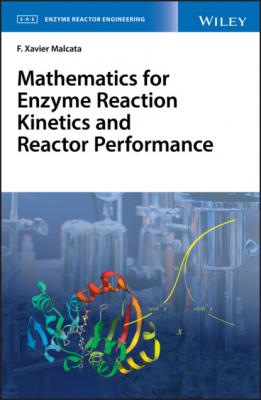Mathematics for Enzyme Reaction Kinetics and Reactor Performance. F. Xavier Malcata
Читать онлайн.| Название | Mathematics for Enzyme Reaction Kinetics and Reactor Performance |
|---|---|
| Автор произведения | F. Xavier Malcata |
| Жанр | Химия |
| Серия | |
| Издательство | Химия |
| Год выпуска | 0 |
| isbn | 9781119490333 |
supplementary use of Eq. (4.4) unfolds
with the aid of the associative property of addition of scalars, while elimination of the right‐hand side between Eqs. (4.12) and (4.15) gives rise to
(4.16)
– meaning that addition of matrices is associative.
For every (m × n) matrix A, there is a null matrix 0m×n such that
(4.17)
in agreement with Eq. (4.2), where Eq. (4.4) prompts transformation to
in view of 0 being the neutral element for addition of scalars; Eq. (4.18) finally gives rise to
again at the expense of Eq. (4.2). Therefore, 0m×n plays the role of neutral element with regard to addition of matrices, i.e. it leaves the other (m × n) matrix (to which it is added) unchanged.
4.2 Multiplication of Scalar by Matrix
Given a generic scalar, say, α, another operation can be defined encompassing matrix B of any type, viz.
with the aid of Eq. (4.3); this is termed multiplication of scalar by matrix. In view of Eqs. (4.3) and (4.20), one has that
(4.21)
which may be rewritten as
(4.22)
due to the commutativity of addition of scalars – or, upon use of Eq. (4.20) backward,
(4.23)
Eq. (4.3) may again be recalled to write
known as commutative property of multiplication of scalar by matrix – even though the scalar is normally placed up front relative to the matrix, for a matter of convention.
If a second scalar is invoked, say, β, then Eq. (4.9) supports
(4.25)
where application of Eq. (4.20) unfolds
(4.26)
a second application of Eq. (4.20) yields
(4.27)
together with the associative property of multiplication of scalars. Final backward application of Eq. (4.20) gives rise to
(4.28)
or, equivalently,
due to Eq. (4.9); one usually refers to Eq. (4.29) as associative property.
If addition of matrices and multiplication of scalar by matrix are considered simultaneously, then one gets
(4.30)
as per Eqs. (4.3) and (4.9), with Eq. (4.4) supporting transformation to
(4.31)
Equation (4.20) may now be invoked to write
(4.32)
complemented with the distributive property of multiplication of scalars – where application of Eqs. (4.4) and (4.20) leads to
(4.33)
or, once Eqs. (4.3) and (4.9) are taken into account,
